Technology of “drawn sound”: sound synthesis in the USSR of the 30s of the XX century
 At the end of the 20s of the 20th century, a sound film began to walk across the planet in unhurried monophonic steps. Cinematographers of the "old school" talk about the loss of expressiveness and that only in silent films the play of actors has the greatest meaning.
At the end of the 20s of the 20th century, a sound film began to walk across the planet in unhurried monophonic steps. Cinematographers of the "old school" talk about the loss of expressiveness and that only in silent films the play of actors has the greatest meaning.In addition to the filmmakers who adopted the invention of sound cinema and began to develop in the framework of the new conditions, there were those who were ahead of their time and, in the absence of advanced technologies, tried to create things that were realized much later in the framework of scientific and technological progress.
"Drawn sound." The technology developed by a group of enthusiasts in the 30s of the XX century, long before the invention of sequencers and synthesizers. It allowed the method of artificially creating graphics sound tracks on film to synthesize any sounds, effects, record complex polyphonic works.
 Composer Arseny Avraamov, designer Evgeny Sholpo and director-animator Mikhail Tsekhanovsky in the process of working on one of the first Soviet sound films “Five-Year Plan. Great Work Plan "came to the idea of the technique of hand-drawn sound. When the first reels of the film were shown, Tsekhanovsky, admiring the beauty of the patterns of the sound track, expressed the idea: “I wonder if you can shoot Egyptian or ancient Greek ornaments on this track - will the archaic music unknown to us suddenly sound?” Roughly speaking, the idea of “drawn sound” evolved from simple human curiosity. This happened in October 1929.
Composer Arseny Avraamov, designer Evgeny Sholpo and director-animator Mikhail Tsekhanovsky in the process of working on one of the first Soviet sound films “Five-Year Plan. Great Work Plan "came to the idea of the technique of hand-drawn sound. When the first reels of the film were shown, Tsekhanovsky, admiring the beauty of the patterns of the sound track, expressed the idea: “I wonder if you can shoot Egyptian or ancient Greek ornaments on this track - will the archaic music unknown to us suddenly sound?” Roughly speaking, the idea of “drawn sound” evolved from simple human curiosity. This happened in October 1929.')
The laboratories created soon became the world's first prototypes of future computer music research centers. Basically, an applied film music was created, the result of the work was film dubbing. The most famous are the works of Evgeny Sholpo, the inventor of the Variophon instrument, the composer and researcher Arseny Avraamov, who dealt with the problems of ultrachromatic music, and Nikolai Voinov, who created Nivoton. In the pre-tape era, as part of the technique of drawing sound, these researchers tried to create a technology that is traditionally considered the highest achievement of computer music technology of the 90s of the twentieth century.
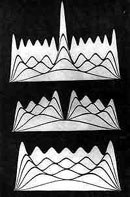
The main purpose of the “drawing sound” technology is the synthesis of sounds that expand the sound of conventional orchestral instruments, as well as the creation of “hybrid” sounds, the sound of which cannot be reproduced with conventional instruments. At first, the theoretical base of the technology was developed by a large team, banks of graphic “samples” were going to be put together, so to speak: the calculations were made according to which the draftsmen created graphic copies of real sounds, from a large number of sounds actually recorded and translated into celluloid, the necessary sounds were extracted.
Subsequently, the team was divided, which allowed the technology to go in several ways.
Yevgeny Sholpo. "Variophone"
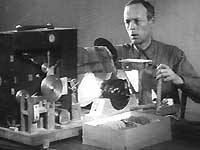 The Variophon electro-optical synthesizer was invented by Eugene Sholpo during his work at the Central Wire Communication Laboratory in Leningrad. In 1930, Sholpo patented the principle of the instrument. The new device allows you to synthesize artificial sound tracks in the technique of automated "paper sound". The first wooden version of the instrument was built in 1931 with the participation of composer George Rimsky-Korsakov (grandson of composer Nikolai Rimsky-Korsakov). The wooden parts of the instrument were tied with twine, fastened with screws and adjusted using special ropes. However, in comparison with later versions of the instrument, the first model provided the best quality and complexity of the synthesized sound. The variophon allowed an arbitrary change in pitch, the possibility of receiving glissando, vibrato, hues, changes in sound power, the construction of polyphonic chords (up to 12 simultaneously sounding voices).
The Variophon electro-optical synthesizer was invented by Eugene Sholpo during his work at the Central Wire Communication Laboratory in Leningrad. In 1930, Sholpo patented the principle of the instrument. The new device allows you to synthesize artificial sound tracks in the technique of automated "paper sound". The first wooden version of the instrument was built in 1931 with the participation of composer George Rimsky-Korsakov (grandson of composer Nikolai Rimsky-Korsakov). The wooden parts of the instrument were tied with twine, fastened with screws and adjusted using special ropes. However, in comparison with later versions of the instrument, the first model provided the best quality and complexity of the synthesized sound. The variophon allowed an arbitrary change in pitch, the possibility of receiving glissando, vibrato, hues, changes in sound power, the construction of polyphonic chords (up to 12 simultaneously sounding voices).
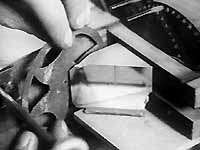 The tool uses rotating discs with cut-out teeth of a sound wave shape (transversal contour), periodically interrupting a beam of light that forms the outlines of the sound track. Filming is done directly on the moving film using a special transmission that transmits the rotation of the electric motor, which drives the circuit, to the mechanism that pulls the film. Unfortunately, "Variofon" was destroyed during the bombing of besieged Leningrad.
The tool uses rotating discs with cut-out teeth of a sound wave shape (transversal contour), periodically interrupting a beam of light that forms the outlines of the sound track. Filming is done directly on the moving film using a special transmission that transmits the rotation of the electric motor, which drives the circuit, to the mechanism that pulls the film. Unfortunately, "Variofon" was destroyed during the bombing of besieged Leningrad.Despite the sound, reminiscent of modern eight-bit music, Variophon had one fundamental difference - rhythm. Sholpo technology allowed to model the most subtle rhythmic nuances of live performance - Rubato, Rallentando, Accelerando.
“Come on, sing a song for us, a cheerful wind ...” by Isaac Dunaevsky, synthesized on the Varyophone
"Flight of the Valkyries" by Wagner, synthesized on the Varyophone
Arseny Abraham. "Ornamental sound"
The technique of ornamental sound was developed by Arseny Avraamov in 1929-1930. Artificial sound tracks, first demonstrated by Abraham in 1930, are based on geometric profiles and ornaments (illustration at the top of the post) , obtained by purely drawing methods, followed by photographing frame by frame on an animation machine. In the autumn of 1930 in Moscow, Arseny Avrahamov created the Multzvuk laboratory. The first ornamental sound tracks were worked on: the operator Nikolay Zhelinsky, the animator Nikolai Voinov and the acoustics Boris Yankovsky, who was responsible for the transfer of musical scores into the microtonic system of the Welttonsystem Avrahamov. By the middle of 1933, more than 1,800 meters of film were filmed by the Avraamov group. About half of the material consisted of musical excerpts with new ober-untertonic harmonies.
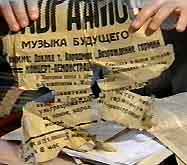 In the fall of 1931, the group moved to NIKFI - Research and Development Film and Photo Institute and was renamed the laboratory "Sintonfilm". In December 1932, NIKFI conducts downsizing, and the laboratory moves to Mezhrabpomfilm, where in 1934 it was finally closed down as not economically viable. The archive of the laboratory (about 2,000 meters of film) was stored in the apartment of Arseny Avraamov, where he died in 1936-1937 during his host's long stay in Kabardino-Balkaria (the sons of Abraham used combustible nitroplina as fuel for improvised rockets and smoke screens), all that left from the archive - in the illustration to the right.
In the fall of 1931, the group moved to NIKFI - Research and Development Film and Photo Institute and was renamed the laboratory "Sintonfilm". In December 1932, NIKFI conducts downsizing, and the laboratory moves to Mezhrabpomfilm, where in 1934 it was finally closed down as not economically viable. The archive of the laboratory (about 2,000 meters of film) was stored in the apartment of Arseny Avraamov, where he died in 1936-1937 during his host's long stay in Kabardino-Balkaria (the sons of Abraham used combustible nitroplina as fuel for improvised rockets and smoke screens), all that left from the archive - in the illustration to the right.Boris Yankovsky. Sintons and Vibroexponentier
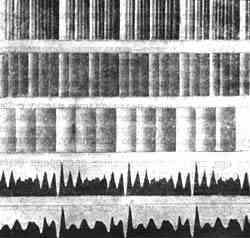 In 1932, disappointed in the technique of ornamental sound, Boris Yankovsky left the Multzvuk Avraamov group and set up his own laboratory. Acoustic Yankovsky, unlike most of his colleagues, clearly understands that the graphic pattern defining the shape of the sound wave does not yet determine the timbre. Only the spectrum of sound, with all the nuances of transient dynamics, gives a complete acoustic picture. Yankovsky was the only researcher of the methods of spectral analysis, decomposition and resynthesis. He believed in the possibility of creating a universal library of sound elements, similar to the periodic table.
In 1932, disappointed in the technique of ornamental sound, Boris Yankovsky left the Multzvuk Avraamov group and set up his own laboratory. Acoustic Yankovsky, unlike most of his colleagues, clearly understands that the graphic pattern defining the shape of the sound wave does not yet determine the timbre. Only the spectrum of sound, with all the nuances of transient dynamics, gives a complete acoustic picture. Yankovsky was the only researcher of the methods of spectral analysis, decomposition and resynthesis. He believed in the possibility of creating a universal library of sound elements, similar to the periodic table. 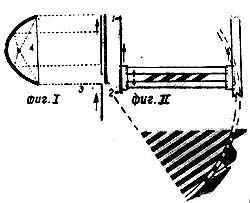 His graphic curves - "spectro standards" - were semiotic units, combining which you can get new sound hybrids. In addition, he developed a number of ways to transform sound, including a technique for varying the duration of a sound without changing its pitch and a transposition technique based on the separation of the spectral composition and formant, methods similar to modern cross-synthesis techniques and phase vocoder, widely used in computer music. For the practical implementation of his work, Yankovsky invented a special tool “Vibroexponentier” (the diagram in the illustration on the right) .
His graphic curves - "spectro standards" - were semiotic units, combining which you can get new sound hybrids. In addition, he developed a number of ways to transform sound, including a technique for varying the duration of a sound without changing its pitch and a transposition technique based on the separation of the spectral composition and formant, methods similar to modern cross-synthesis techniques and phase vocoder, widely used in computer music. For the practical implementation of his work, Yankovsky invented a special tool “Vibroexponentier” (the diagram in the illustration on the right) .Unfortunately, the plans of Jankowski to develop his brainchild destroys the war. After arriving from evacuation in 1949, he no longer returns to the theme of graphic sound.
Nikolai Voinov. "Nivoton" and "Paper Sound"
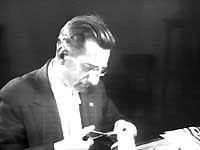
 In 1930, cameraman Nikolai Voinov joined the Multzvuk group of Abraham in the process of working on the first drawn soundtracks. In 1931, he left the group and began his own research in the field of so-called paper sound, based on the synthesis of sound tracks by adding the sound wave profiles cut out of paper using the Nivoton tool, followed by photographic fragments of the sound track on an animation machine. Since 1931, Voinov has been part of the IVOS group (Ivanov, Voinov, Sazonov), which has created a whole series of animated films with synthetic sound tracks: “The Lady” (1931),
In 1930, cameraman Nikolai Voinov joined the Multzvuk group of Abraham in the process of working on the first drawn soundtracks. In 1931, he left the group and began his own research in the field of so-called paper sound, based on the synthesis of sound tracks by adding the sound wave profiles cut out of paper using the Nivoton tool, followed by photographic fragments of the sound track on an animation machine. Since 1931, Voinov has been part of the IVOS group (Ivanov, Voinov, Sazonov), which has created a whole series of animated films with synthetic sound tracks: “The Lady” (1931), 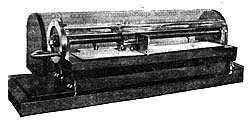 “Prelude Rakhmaninov” (1932), “Dance of the Crow” (1933), “Colored fields and security lines” (1934), “Thief” (1934).
“Prelude Rakhmaninov” (1932), “Dance of the Crow” (1933), “Colored fields and security lines” (1934), “Thief” (1934).In early 1936, Voinov was dismissed from the Mosfilm factory, his laboratory closed. Until the end of his life, he worked as an operator for the Soyuzmultfilm studio. In the official biography of Voinov his experimental works of the 1930s are practically not mentioned.
"Prelude" Rachmaninoff, 1932
Explanation of the principles of the work of the "paper sound" equipment and the demonstration of the cartoon "Dance of the Crow", 1933
“The Thief”, 1934. By the way, in some moments it resembles a completely modern chiptune. Particularly interesting sound effects simulated in this technique.
In fact, in the early 30s of the twentieth century, Soviet researchers were able to sample, synthesize the sounds of musical instruments, the human voice (by the way, there were rumors that the developers of the technology were able to synthesize Lenin's voice), various noises. Polyphonic and orchestral scores were synthesized on the basis of artificially created sounds, films were voiced.
It should be said that later similar experiments with drawn soundtracks were carried out in Germany by Walter Ruttman and Oscar Fisheringer, staying within the simplest technique of working with a sound wave, as well as Norman McLaren in Canada. We can safely say that our inventors once again were "ahead of the rest."
In preparing the article, materials were used from lectures by Alexander Smirnov ( Theremin Center ), publications by Nikolai Izvolov, materials from the Generation Z blog.
Source: https://habr.com/ru/post/182778/
All Articles